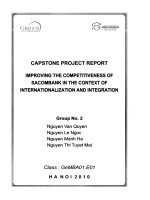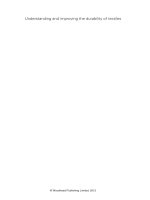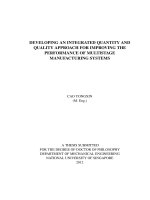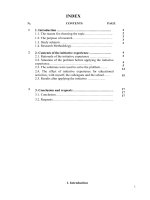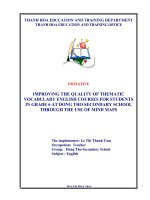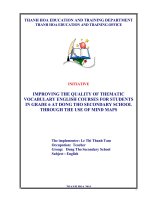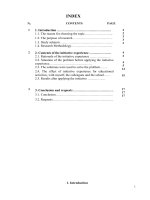skkn improving the tenth graders’ written work through the teaching of text type
Bạn đang xem bản rút gọn của tài liệu. Xem và tải ngay bản đầy đủ của tài liệu tại đây (174.65 KB, 11 trang )
SỞ GIÁO DỤC VÀ ĐÀO TẠO ĐỒNG NAI
Trường THPT TRẤN BIÊN
Mã số: ................................
SÁNG KIẾN KINH NGHIỆM
Improving the tenth graders’ written work
through the teaching of text type
Người thực hiện: NGUYỄN TRẦN TỐ NỮ YẾN ANH
Lĩnh vực nghiên cứu:
- Quản lý giáo dục
- Phương pháp dạy học bộ môn: TIẾNG ANH
- Lĩnh vực khác:
Có đính kèm:
Mô hình
Phần mềm
Phim ảnh
Năm học: 2012-2013
1
Hiện vật khác
September, 2012
INTRODUCTION
Writing is one of the two important productive skills that high school students need to improve or
to develop so that they can become competent English users in the learning process. However,
helping students to write effectively is still a difficult job for Vietnamese teachers, especially
teachers at high schools.
The purpose of this research is to investigate how the genre-based approach, using text type in
teaching writing would help improve grade-ten students’ work on information report. The research
is conducted with two groups of the tenth graders in Tran Bien High School. The experimental
group is taught writing with the implement of text type. In the control group, on the other hand, no
changes would be made.
CONTEXT
Tran Bien High School, which is about 30 kilometers from Ho Chi Minh City. is located in
Bien Hoa City, Dong Nai Province. The school has a teaching staff consisting of 99 teachers who
are in charge of thirteen subjects. Each year the school has totally 40 classes including more than
1200 students (from grade ten to grade twelve). In each class, some students are rather good at
English. While. Others are of lower-intermediate or intermediate proficiency at English.
The school has an English section consisting of ten teachers who all graduated from Ho Chi
Minh University of Pedagogy(Education) . Two of them have got a Master Degree in English
Teaching, while five have been teaching English for more than twenty years. I have been teaching
English for 9 years. Although some of us are textbook-bound and have a very traditional way of
teaching, which pays much attention to grammar, vocabulary and the reading of text selections
through the curriculum, most of us are enthusiastic and experienced in teaching.
RATIONALE
Writing is a social activity and the texts we produced are shaped by the social contexts in
which they occur. Pedagogically speaking, writing is among the four macro-skills that learners need
to master when studying a second or foreign language. Text level is targeted in teaching writing. At
this level, it is important for the learners to consider the purpose of their writing, the intended
audience, and the text structure. These components decide on the language choice, and the
organization of ideas. It is the text structure, among the three, that constrains the learners, enforcing
construction patterns that help them express their purpose.
In recent years there have been efforts among teachers to improve Vietnamese high school
students’ writing skills. These efforts have been especially true in the case of concentrating on the
real communicative purpose of writing. However, when working the students I have known that
they have met a lot of problems with their writing lessons. Some of my grade-ten-students cannot
find the right ideas for their writing. Other students, though, have a number of interesting ideas, fail
to make their writing understood. Even my good students have problems arranging the contents in a
communicative purpose. When conducting some interviews and examining the students’ written
work on information report, I have realized that my students do not show a positive attitude to their
writing lessons and writing tasks. I am also aware of the reasons leading to their poor writing.
Firstly, writing is academically a productive skill which needs students to produce meaningful
texts to serve specific purposes and to address to a certain group of people. Secondly, rubrics for
2
scaffolding their writing are ignored. Nearly all of the English teachers in my school apply the
product-oriented approach which encourages the students to either copying or transforming
separated sentences in correct language. Finally, much schema is required before students can
actually come up with their own ideas for a writing text. Schematic knowledge enlists a knowledge
of genres or text types, general world knowledge, socio-cultural knowledge, and topic knowledge.
Among the other things, the main cause of my student’s low performance in English writing (such
as: information report) is the lack of genre-specific writing across the curriculum. The introduction
of text type, therefore, becomes a real practical need for both the teaching and learning of writing in
my school.
This research studies the impacts of teaching text types on the tenth graders’ written work on
information report and argues that the pedagogical using of text type can bring dramatic betterment
in our writing lessons as well as improve students’ written work. When implementing the genrebased pedagogy using text-type in teaching writing information report I anticipate profitable
changes, aiming at bringing a new critical perspective in our daily teaching practice.
Research Questions
1. What is the current quality of students’ writing on information report?
2. What are some problems with the teaching and learning information report as a text type in
Tran Bien High School?
3. To what extent does the pedagogical using of text types help improve students’ written work
on information report?
LITERATURE REVIEW
Text types, known as genres refer to the way in which the contents or ideas of a certain
written work are organized. Each text type or genre serves a particular purpose and is addressed to a
certain number of the intended audience. Different texts vary in generic structure and linguistic
features. “Knowing how to identify and construct text types is the basic of literacy” (Anderson &
Anderson, 1998, p.4).
It is believed that classifying and deconstructing text types bring students great benefits as
they acknowledge how certain texts are composed for specific purposes. This leads to their
awareness of creating linguistically accurate and socially appropriate texts. Hyland (2003) claims
that when taking a genre orientation to writing construction, teachers are concerned with teaching
learners the way to use language patterns to accomplish coherent purposeful prose. Learners are
encouraged to see writing as endeavors to communicate with readers. Novice writers should be
aware that when writing they are trying to do something with the language they use: it is a way to
get something done. To my stance, whether learners are to tell a story, to describe a technical
process, to argue for something and so on, they have to follow certain social conventions for
organizing messages so that their intended audience can recognize their purpose. Hence, recognition
of text types is crucial for students to engineer their ideas.
In my own experience of teaching, the teaching of text type is the process of familiarizing
students with a great variety of generic conventions and linguistic properties. It provides students
with knowledge of the social context within which texts are situated as well as their social functions.
As the teaching of text types should be based on good scaffolding and explicit teaching, students
benefit from the large exposure to a variety of text types, and, therefore have a sense of flexibility
3
when asked to construct their own writing. In genre-based approach the introduction of text type
comprises of the two phases namely building the field and modeling the text (Derewianka, 1990).
Before learners are ready to produce their own written work, it has always been better for them to be
fully exposed to text construction and language mechanics used to express certain purposes
(Paltridge, 1996). Harmer (2004) believes that building the writing habit (with activities) is of
extreme importance but without experiencing examples of various text types to see how they are
constructed, students are unlikely to become effective writers.
To my own viewpoint, this approach provides a fundamental framework for the students to
see how certain texts are differently constructed according to their social functions and writer’s
intention. It helps build students’ background and gives them a sense of preparation for what they
will be writing. Nunan (1991) hypothesizes that textual analysis helps student writers recognize
characteristics that distinguish one type of text with the others; therefore it provides students with
valuable insights into how various types of text are socially and functionally constructed. Similarly,
Hedge (2000) points out four advantages of having students interpret the generic structure of
different text types. These include “helping students to identify their writing needs, building
awareness of discourse organization, helping students to develop crafting skill and enabling students
to appreciate the criteria for an effective text.” (p.323)
There are, however, some feasible disadvantages of this approach.
Some critics may argue that this writing approach is “extremely prescriptive” rather than
“descriptive” (Harmer, 2007) and that the approach underestimates “the skill needed to produce a
text and see learner as largely passive” (Badger & White, 2000). I deeply understand that the
teaching of text type pays much attention to the textual analysis and limits learners to replicating
what others have written. Consequently, there may be little room for creativity from learners.
However, these limitations are outweighed by the benefits the approach brings about. In actual fact,
they can be overcome by better classroom practice from the teachers. It is recommended that they
introduce students a number of text types whose examples are all differentiated, so that they can
both recognize the similarities between them and become fully aware of how they are differently
structured (Harmer, 2004). Another way to get the best of the approach, according to Beverly
Derewianka, is to teach writing through a curriculum cycle which encompasses of the four stages
known as building the field, modeling the text, joint construction and independent construction of
text (Derewianka, 1990)
After studying more about the genre-based approach, I decide that the teaching of text type
is suitable for my teaching context where there is little introduction of linguistic features and text
structure. By implementing this approach, I hope to assist my students get a better view of how to
construct information report which is included in the English syllabus for tenth graders. In this
research I will stage how I would apply this text type-based approach to my teaching environment in
the most beneficial way for my students who are typically stereotyped as “low” at writing skills.
Expected Outcomes
When carrying out the research I hope to receive both the teachers and students’ positive
attitude to the new teaching method. Also, I anticipate some improvements in the experimental
students’ written work in the two post-tests. If successful, I can actually generalize the implement of
teaching text type on a larger number of students.
4
Conclusion and Recommendation
In last analysis, I am aware that written communication in the classroom requires the three
main components of effective teaching methods, constraint-minimizing measures and involving
students in meaningful communication activities, like using text types. The above analysis
indicates that only in teaching situations that follow this way of such a combined technique, can
we promote and achieve the written communicative goal in the classroom. In the Vietnamese
teaching situations, written communication in English teaching is impossible without using text
types.
APPENDICES
APPENDIX 1:
INFORMATION REPORT
An information report is a factual text, which means it classifies and describes information about
phenomenon (its parts, behavior, characteristics, etc) in the real world. An information report
is used as a way to gain a better understanding about a living or non-living subject.
(Anderson, M & Anderson, K 1998)
Examples of information reports
Topics, or subjects, found in information reports can be about one specific thing or a group of
things. Some examples of topics might include: cars, ocean animals, rainforest, pollution, etc.
Language features (*)
Information reports:
• use technical language related to the subject.
• employ generalized terms
• use timeless present tense
• tend to be in the third person
• tend to use simple or compound sentences to keep things clear
• use connectives to indicate time, cause, effect or comparison
• do not contain personal views
• are usually written, but can also be presented orally (spoken).
Design features (*)
Title
Subheadings
Text- bold, color, italics
Photographs / illustration
Captions
Textbox
Maps, Diagrams, Tables
Timelines
(*) Taken from Pillay, H. (2010). Lecture notes. RELC, Singapore.
•
•
•
•
•
•
•
•
5
The steps for constructing an information report: (Anderson & Anderson, K. 1998)
• A general opening statement that introduces the subject of the report. (the first paragraph)
- Tells audience what the text is going to be about
- Can include a short description of the subject
- Can include a definition of the subject
• A series of paragraphs about the subject
- Each paragraph usually begins with a topic sentence
- The topic sentence at the beginning of each paragraph previews the information contained in
the rest of the paragraph
- The sentences after this preview give more details
- Each paragraph should give information about one feature of the subject
- These paragraphs build a description of the subject of the report
- These paragraphs may include technical language that is related to the subject
• A concluding paragraph (optional)
- Can merely signal the end of the text
- Can also summarize the report
APPENDIX 2
•
SAMPLE OF PRE-TEST
Write a short essay (150 words) about giant pandas, based on the in formation given.
GIANT PANDAS
-
Habitat: Bamboo forests in mountains in central and western China.
Population: Only about 600
Height: 1.2 to 1.5 m
Weight: 75 to 160 kg
Food: Bamboo
Life span: About 20 to 30 years
Reason for decline: Habitat destruction and illegal trading
SAMPLE OF POST-TEST
•
•
Write a short essay (150 words) about endangered species of animals, based on the
information given.
DOLPHINS
-
Range & Habitat: Oceans worldwide – Prefer coastal waters and bays
Size:
+ Smallest about 50 kg and 1.2 m / + Largest: up to 8,200 kg and 10 m
Feeding habits: Carnivores. Eats mostly fish
Offspring: Give birth to one calf every 2 years
+ Gestation period: 11-12 months
- Life span: From 25 to 65 years. Sometimes longer, depending on the species
- Special features: Mammals, not fish. Among the most intelligent animals
- Conservation concerns: At risk due to habitat pollution and accidental fishing net entrapment.
6
HOLISTIC MARKING SCHEME FOR WRITING PRE-TEST AND POST-TEST
Marks
Criteria
10
- Ideas – very substantial, very relevant and very logical. All ideas are well
developed and supported.
- Organization of ideas is very coherent and well-organized. Very adequate
paragraphing with very appropriate topic and supportive sentences. Very smooth
flow of ideas with excellent use of cohesive devices.
- Language – Excellent command of English. Very frequent use of excellent
complex sentences without any errors. An impressive range of appropriate
vocabulary and idiomatic language is used.
- Evident display of impressive creativity and flair throughout the writing.
8-9
- Ideas – substantial, relevant and very logical. Most ideas are well developed and
supported.
- Organization of ideas is generally coherent and well-organized. Adequate
paragraphing with very appropriate topic and supportive sentences. Smooth flow of
ideas with use of cohesive devices.
- Language – Good command of English. Frequent use of complex sentences with
occasional minor errors. A wide range of appropriate vocabulary and idiomatic
language is used.
- Good display of creativity and flair throughout the writing.
6-7
- Ideas – reasonably substantial, relevant and fairly logical. Some ideas are well
developed and supported.
- Organization of ideas is satisfactorily coherent. Flow of ideas is occasionally
hindered by paragraphs with inappropriate topic and supportive sentences. Smooth
flow of ideas with use of cohesive devices.
- Language – Satisfactory command of English. Frequent use of complex sentences
with rather frequent minor errors and occasional gross errors are evident. A
- Satisfactory display of creativity and flair in most parts of the writing.
4-5
- Ideas – fairly substantial, occasionally irrelevant and lack logic. Some ideas lack
elaboration and supported.
- Organization of ideas is generally weak. Flow of ideas is evidently impeded with
one or two weak paragraphs. Occasional inappropriate topic and supportive
sentences. Fair use of cohesive devices.
- Language – Fair command of English. Frequent use of compound sentences.
Complex sentences are few with frequent minor errors and occasional gross errors.
A fair range of appropriate vocabulary. Limited use of idiomatic language.
- Occasional display of creativity and flair in writing. Generally, a conventional
way of writing.
2-3
- Ideas – inadequate, frequently irrelevant and illogical. Many ideas lack elaboration
and supported.
- Organization of ideas is evidently weak. Flow of ideas is evidently erratic and
awkward. Most paragraphs are poor with frequent inappropriate topic and
supportive sentences. Weak command of English. Mostly simple sentences are used.
Frequent gross errors. A limited range of vocabulary. Hardly any use of idiomatic
language.
- Hardly any display of creativity and flair in writing.
0-1
- Ideas- barely adequate, irrelevant and not logic. Little / no evidence of ability to
put forth ideas.
7
- Coherence is absent in text.
- Very poor command of English. Numerous errors impeding fluency of
communication.
- No creativity at all.
APPLICATION
The following adapted task illustrates the use of text types(the Genre approach) in teaching
writing at Tran Bien High School.
COURSE BOOK: ENGLISH 10
Unit 9: UNDERSEA WORLD
Question: Write a paragraph that describe sperm whale
(page 100)
Activities
I. Aims: Students are able to understand the objectives and structure of an information report genre
and the processes involved, such as pre-writing, drafting, revising and editing. They will be able to
make good use of the knowledge to produce a text in groups and individually.
Activity 1 :(15minutes)
Objectives:
The purpose of this activity is to activate schema and provide the context for students to construct
their writing.
Procedure:
o The teacher gives the students the topic for discussion, and encourage them to discuss in
groups of six:
“We are going to write about a very lovely and intelligent animal “the sperm whale”.What
adjectives and ideas we can use to describe the sperm whale.”
o Highlight that the purpose of the lesson is to write about sperm whale, a very important
animal.
o Elicit the key word ‘lifespan’ through question like “What is the life span of a sperm
whale?”
o Explain to students that they are going to learn a genre of writing called “information
report”.
8
Activity 2 (15 min)
Objectives:
To reinforce the purpose of an information report essay by providing students with a basic
understanding of the information report genre.
Procedure:
o Distribute information report text for all the students to get familiar with language patterns..
o Encourage students to read on their own and bear in mind the following questions:
-What is the purpose of the text?
-Who do you think it is written for (target audience)?
-Did the writer achieve the purpose?
- Do you think the text is natural and meaningful? Why?
o After students finish reading, review the questions and summarize main points.
Activity 3 (25 min)
Objectives:
To allow students to be familiar with the structural features of a typical information report
Procedure:
o Encourage students to re read the given text and pay special attention to structural features
by focusing on the following questions:
-How does the text start and end?
-What is the pattern/sequence you see in the text?
-What are the different stages in the text that you can identify?
-What does each stage function as?
o Students to work in groups and discuss their findings after re reading the text.
o Get a representative from each group share their findings and ideas with the class.
o Once every group has presented, consolidate the learning points. As a reinforcement,
explicitly teach on the structural features in the writing that make it connective using. Clearly
mark/highlight the features on the sample text.
Activity 4 (25min)
Objective
To allow students to compare good and bad examples of an information report essay and reinforce
their understanding of the structural features.
Procedure:
o Distribute another sample information report text that has random order of structure.
o Allow students enough time to read and compare it with the earlier sample using the
following questions as criteria:
What is the purpose of the text?
9
Do you think this text achieve its purpose like the first one does? Why.
o Discuss the responses with the students
o Pupils to work in pairs and reorganize and improve the random structure according to the
different stages of information report text.
o Encourage students to improve the text’s effectiveness in persuading audience/readers.
o Get pairs to exchange and read each other’s results.
o Consolidate the results with class and clarify important points raised.
Activity 5 (10 min)
Objective:
To arouse students’ interest in the topic for the writing lesson and prepare them for the joint
construction of the text.
Procedure:
Revisit the context and ask students to focus on the word ‘mobile phones’.
Write the word and create a word map.
Students to brainstorm about things related to the words ‘sperm whale”. Teacher to list them on the
word map as students contribute.
Activity 6 (15 min)
Objective:
To provide students with the opportunity to produce a plan for an argumentative text (using a
graphic organizer) as a class, in preparation for individual work.
Procedure:
o .Tell them to adopt the following position: “We love animals and we love sperm whale.”
o Demonstrate the process involved in producing text by eliciting responses from students and
suggestions about the structure of the text.
o As students contribute, write the text clearly on the board or visualize so that students can
focus on the meanings that they create.
o Preview the jointly constructed graphic organizer.
o Make revision where necessary.
o Clarify and consolidate major points.
Concluding Activity 7 (20 min)
Objective: Students to apply what they have learnt to write their first draft independently.
Procedure:
o Present the context again to students.
o Instruct them to write individually on the given topic.
o Encourage students to present their own ideas and perspectives.
o Offer guidance to students where necessary.
o If students are unable to finish within the allocated time, allow them to complete their first
draft as homework and bring it the next lesson for revising.
10
o In the next lessons, teachers will give more time for students to revise and edit their
individual piece of writing.
REFERENCES
Anderson & Anderson, K. (1998). Text types in English. Australia: Macmillan Education.
Badger, R. & White, G. (2000). Product, process and genre: Approach to writing in EAP. ELT
Journal, 54(2), 153-160.
Derewianka, B. (1990). Exploring how texts work. Australia: Primary English teaching
Association.
Harmer, J. (2004). How to teach writing. UK: Longman, Pearson Education Limited.
Hedge, T. (2000). Teaching and learning in the language classroom. Oxford: Oxford University
Press.
Hyland, K. (2003). Second Language Writing. Cambridge: Cambridge University Press.
11
